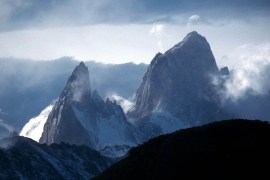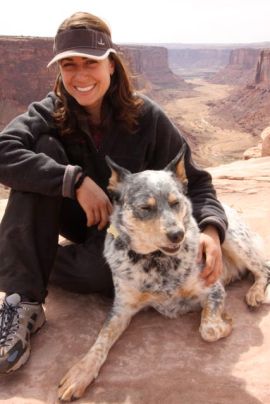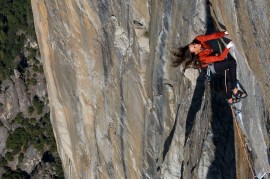
Davis on El Capitan
Steph Davis climbs such outrageously steep things that one wonders whether sorcery is involved, that perhaps her gifts extend beyond climbing to include the manipulation of physics. She has put up first ascents on the world’s most frightening big-walls, from mountains in Pakistan and Baffin Island to Kyrgyzstan.
Davis is the first woman to free climb the Salathe Wall on El Capitan in Yosemite and to summit Torre Egger in Patagonia. She has also become an expert in BASE jumping (the acronym stands for Building, Antenna, Span, and Earth), a wild and unforgiving off-shoot of skydiving.
Yet Davis is also a scholar and accomplished writer. Her masters degree in literature focused on the canon of mountaineering literature. In her book, High Infatuation, Davis asks difficult questions about high-risk climbing, examining her own motives, personal relationships, and the broader meanings of her life’s work.

Mt Fitzroy, Patagonia
Welcome Steph Davis.
You’ve done some amazingly dangerous climbs, from Mt Fitztroy in Patagonia to the Salathe Wall on El Capitan. When you pursue projects like these, how do think through the risks? Is there a red line that you won’t cross? Or does the line change as you climb?
Climbing varies a lot with risk. For example, free climbing el cap is really difficult, but is much less risky than climbing in the mountains, even if the peak is technically easier to climb. So every style of climbing presents different challenges, in terms of difficult and danger, with lots of blurred lines too. I feel very aware of those elements, and at times I am pulled more towards pushing difficulty, and at other times more pulled toward negotiating risk.
For your masters thesis at Colorado State University, you studied mountaineering literature. Could you talk a bit about your project?
I was in the literature graduate program at CSU, and when the time came to do a master’s project, I tried to think of areas that would interest me. Finally I went to my committee and asked them if I could do the project on mountaineering literature. At the time, this didn’t exist as a field of study there. They were really receptive, and told me if I could write up a bibliography of works with short descriptions as part of the project, they would accept it. I chose a selection of mountaineering and climbing books I found canonical and made the bibliography, and then wrote a thesis project called “the reality of experience in mountaineering literature,” about the ways in which reality can be so disparate and shifting for each individual who is living through extreme experiences. I framed the project as a personal essay, around a summer spent climbing on the Longs Peak Diamond in Colorado, because that was a writing style I was studying a lot.
Do you identify with any particular explorer or mountaineer?
I will always be in awe of Ernest Shackleton, and what he accomplished.
When Darwin went to Patagonia, he carried a copy of Alexander von Humboldt’s Personal Narrative with him, an account of Humboldt’s own journeys through South America. Do you bring books with you on your climbs? Do you ever have other climbers’ experiences in mind as you make your ascent?
When I go on an expedition, I choose carefully since weight allowances force me to limit the books I bring, and I read very fast. So it‘s impossible to bring enough books for a whole trip. I usually try to bring some very thick, dense novels, also some books about natural science. I also bring one or two books in French or Spanish with a dictionary, because those can be entertaining for days. On actual climbs, I can barely spare the weight to bring food, much less books….but if I am climbing big wall style, I will always bring a journal.
You’ve written about the challenges of being a woman rock-climber in a male-dominated sport. Male climbers didn’t always take you seriously or belittled your accomplishments. Has that changed with your success as a climber or do you still feel like you are treated differently?
It has changed. I wrote about that phase in my book, because it was a strange experience for me. As time has gone by, that phase is over, and I’m relieved, because I didn’t appreciate it.
Do you think being a elite women climber affects the way you are treated by sponsors, fans, or the general public?
That is hard for me to answer. I have been climbing for 18 years, half my life, and have been climbing at a high level for a long time. So I don’t have much perspective versus not being that way. People I meet do tell me that they are inspired or motivated by things I’ve done, and that makes me feel good. But I also feel that doing all these things is not really so unique or special. Everyone I meet has done amazing things in life, they just might not have the same sense of drama attached.

Many people can identify with your struggle to balance family relationships with your work. Yet even by these standards, it seems that you spend a great deal of time away from your friends, family, and dog Fletcher. How do you find the balance point in your life between climbing and these relationships?
Living a simple life is really difficult sometimes, oddly enough. For me, the hardest challenge right now is balancing travel with climbing. Travel is about the worst thing I can do for climbing fitness, but sometimes it‘s necessary for work or certain climbing or jumping plans. When I am at home, on a schedule of working out, and living a simple life, I can climb my best. Being in cars and airplanes and not climbing regularly just doesn’t work….so it can be tricky. In recent years I started base jumping and wing suit flying. Now when I am traveling a lot, I take advantage of being in good jumping places, and focus on jumping instead. Which is great. It is also interesting right now, with Fletcher being 15 and very arthritic. She does not travel well, and mostly needs to be at home where she is comfortable since she can’t walk as well. I definitely prefer to do things which don’t require a lot of walking (certain climbing areas with short approaches where I can carry her and good campsites, skydiving at the local airport where she can be at the landing field, base jumps where she can hang out at the landing site) right now. I sometimes have to force myself to go running, because I really miss her when I run. And I worry a lot when I go on a trip for several weeks, right now.
After successfully free-climbing the Salathe Wall, you experienced a period of depression and self-doubt. As I understand it, you were trying to reconcile your beliefs in a philosophy of acceptance and mindfulness with the sometimes obsessive, single-focused determination you needed as a climber to reach your goals. Could you speak a bit about this? Does this conflict still affect you or have you come to terms with it?
The Salathe experience was pretty severe for me, partly because the climb took so much out of me. I was also dealing with a lot of challenges in my marriage, which made things even harder and raised a lot of questions about partnership, support, and giving. So the experience forced me into a lot of self-examination, and also eventually led me to conclude that there are positive ways to organize personal projects, without having to feel like a burden on others. So I feel very happy now when I get enthusiastic about a project, because I have found there are fun ways to involve others, without the sense of imbalanced giving or taking which is so often the characteristic of a major, individual climbing project, and that makes the entire experience very fulfilling.

Davis on the Salathe Wall, El Capitan, Yosemite
It seems to me that the conflict you experienced after climbing the Salathe has parallels in the climbing community where some climbers seek some kind of inner peace or connection with nature whereas others are interested in peak-bagging and new ascents. Could you speak a bit about the culture of elite climbers? Is there a common set of values or is everyone different?
One of the best things about climbing is the fact that people can experience it in so many different ways.
What is your next big project?
Something involving free soloing!
Thanks Steph, good luck and safe travels.
For more on Davis’s writings and climbing career, visit High Infatuation and read my earlier post Lessons of the Free Solo.













What a nice surprise to find this interview here! I was heavily into rock climbing for about five years during grad school in Seattle (I want to get back into it eventually but London’s not the best place for that lifestyle!). At the time I eagerly followed the exploits of elite climbers like Steph Davis. I even have a poster of her free soloing in Indian Creek, Utah which she signed for me at one of her public talks in Seattle and which I still keep pinned above my desk at the Natural History Museum in London. On it, she wrote “Be bold, Be safe”. It’s a simple but provocative message, and not just for climbers.